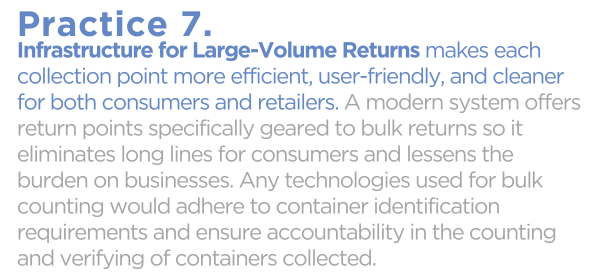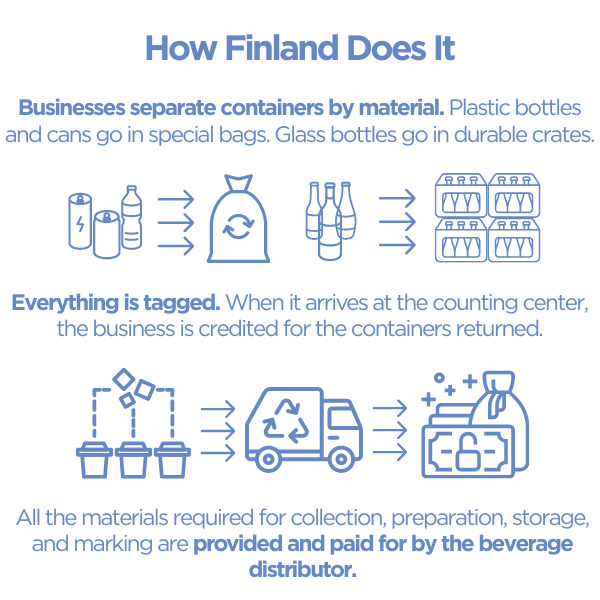This week is lucky Practice 7!
Welcome to the 17th issue of Bottle Bill Common Ground — a limited-series newsletter from Reloop North America highlighting evidence-based guidance for policymakers, industry, and advocates working on bottle bills. (If you haven’t read our first 16 issues, you can do so here.)
We are now focused on 10 essential practices — requirements on how to build, run, and maintain a modern deposit return system (DRS) for beverage containers. The seventh essential practice is:

When it comes to designing and running a DRS, there is no “one size fits all.” It’s crucial to consider the diverse range of users and their specific redemption patterns, as well as the volume of containers they redeem:
- Consumers return a relatively small number of containers to retailers (low volume)
- Canners often collect containers from multiple places but return containers to one spot (often high volume)
- Food service businesses typically generate a significant volume of beverage containers consumed on their premises, and routinely return large quantities of containers (very-high volume)
- Bag drop systems that allow users to collect their containers in bags and deposit them into designated machines or drop-off points (relatively high volume)
In each of these scenarios, user needs can vary significantly. We know from our first and most basic Principle 1: Easy and Equitable that collection points must be user-friendly for the DRS to work well. To maintain ease of use, not to mention system effectiveness, integrity, and transparent tracking of materials and funds, a modern DRS must include specific requirements for high-volume redemption.
Commercial Food Service Establishments (On-Site Consumption)
Just as customers purchasing beverages from a supermarket pay a deposit, businesses pay beverage distributors or wholesalers a deposit on every DRS-covered beverage they buy. However, in the case of beverages consumed on the premises, such as in bars, full-service restaurants, and hotels, the deposit is not passed on to the customers since the business retains the actual containers. Convenient refundability should be guaranteed to businesses, just like individual consumers.
Practice 7 is essential because of the operational challenges in getting high volumes of beverage containers to a redemption center. Hence, many businesses opt to forfeit the deposit altogether. In addition to financial loss for businesses, this forfeiture also means the loss of containers from the deposit system, and their potential landfilling or incineration.
One solution to address this issue is legislative clarity around mandatory distributor take-back requirements. In this scenario, the law makes explicit that beverage companies or distributors are obligated to collect empty containers from businesses, ensuring that those businesses are not burdened with the sole responsibility of managing the returned containers. Ontario, Quebec, Finland, Norway, Estonia, and Lithuania are examples of DRSs with at least some take-back requirements.
Bag Drop and Other Instances of Manual Collection
Minimum standards for high-volume returns are also critical to ensure the accuracy of bag drop and manual collection processes. Requiring containers to be counted using barcodes at some stage of the processing is one way to overcome fraud (harken back to Practice 5: Design, Marking and Registration for Containers). And conducting routine system audits as a regulatory measure goes a long way in protecting system integrity.
Operational standards help ensure a positive redemption experience for users returning large volumes of beverage containers. A common challenge that canners face, for example, is long queues, which hinders efficient refunds. The use of electronic accounts can greatly assist with streamlining operations. These measures also enable transparent recording of money and material flows. Such practices, however, should not overstep privacy or undermine consumer rights. Users should not have to provide a driver’s license or disclose other private information to set up an account, and their refunds should be paid out promptly in cash. Finally, it is important that high-volume return spots not limit the number of containers which can be redeemed per visit.
Minimum standards are critical to ensure accuracy and thwart fraudulent activity in high-volume container return settings. Establishing requirements for high-volume returns puts a DRS on a fair path for all. Protecting the interests of a diverse set of system users, from canners to businesses, is an important component of a high-performing, modern DRS.
Case Study: Finland
Finland’s DRS operator, Palpa, regards commercial sites in the same way it does retail redemption sites. To ensure ease of separation and preparation for collection, businesses are only required to separate containers by material; plastic bottles and cans are each placed into specific bags, while glass containers are placed in durable plastic bins. Each bag or bin is tagged so that once the material is taken to a counting center, the number of collected containers can be calculated and recorded, and the account holder can be refunded the deposit. Refillable bottles are stored in crates and handled by another service provider, but are just as much a part of the DRS. All the materials required for collection, preparation, storage, and marking are provided and paid for by the beverage distributor. (See sources here and here.)

Thanks for reading! We encourage you to share this newsletter widely with those who want or need to know about these principles and practices. Working together from a common ground of knowledge, we can move good bottle bills forward. Sign up here to get these blog posts as emails.
